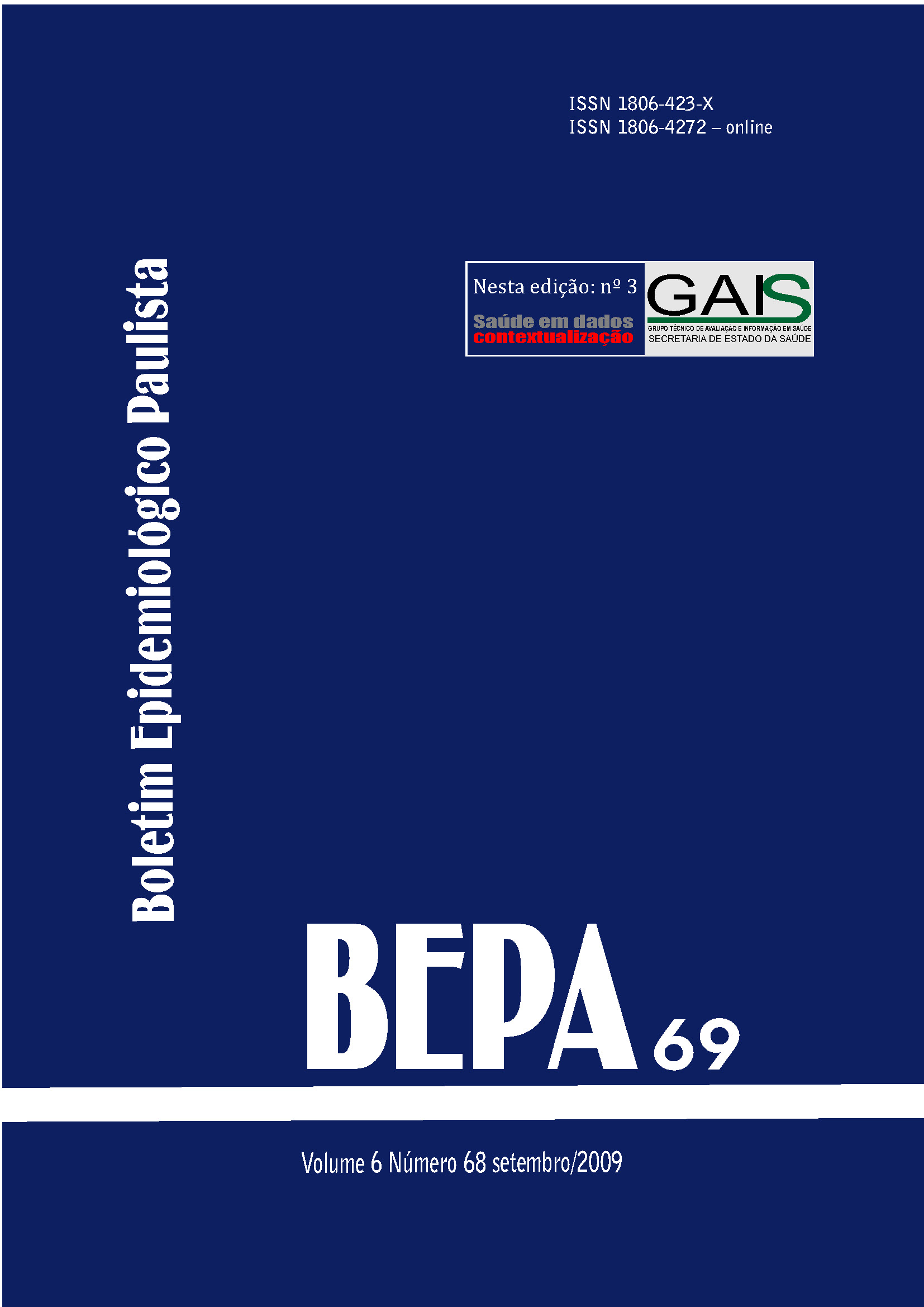Abstract
Brazilian spotted fever (FMB) was first recognized in the state of São Paulo in 1929. After a silent period, it was possible to see the disease reemerge with laboratory confirmation of the first cases, occurring in Pedreira, in 1987, followed by registers of the disease in Campinas and in São João da Boa Vista, Piracicaba, Salto, Mogi das Cruzes, Santo André, São Bernardo, Diadema, Ribeirão Pires, Mauá and the capital of the state. In 2002, this disease was included in the compulsory notification list in the state of São Paulo, but reporting systems were only set up in 2007. During the period from 2003 to 2008, 240 cases of FMB were confirmed in the state, with 71 deaths and registering lethality levels varying from 21,9% to 40,0% during the same period. Epidemiologic investigation charts were analyzed for all confirmed cases according to the technique guidelines of the Epidemiologic Surveillance Center (2002), according to the following characteristics: sex, age, place in which the person was infected, clinical aspects, activity related to the infection. FMB occurred in 61 cities of the state of São Paulo, 23 of whitch located in the region of Campinas. The disease had higher frequency among males, in the age bracket over 10 years of age. Confirmation criteria were serologic for 69% of the cases. It was not possible to determine risk situation for 17,5% of the cases (higher percentages in the patients who died). It is possible to observe that exantema percentages were higher for the persons who were cured (43,5%). There was an increase in the number of cities with the transmission of the disease. It is necessary to confirm if an expansion of transmission areas is occurring or this is only an effect of a better case detection in areas in which the disease was previously unknown.
References
Galvão, MAM, Lamounier JA, Bonomo E, Tropia MS, Rezende EG, Calic SB et al. Rickettsioses emergentes e reemergentes numa região endêmica do Estado de Minas Gerais. Cad Saúde Pública. 2002; 18(6):1593-7.
Galvão MAM, Silva LJ, Nascimento EMM, Calic SB, Sousa R, Bacellar F. Rickettsial diseases in Brazil and Portugal: ocurrence, distribution and diagnosis. Rev Saúde Pública. 2005;39:1-6.
Superintendência de Controle de Endemias - Sucen. Manual de Vigilância Acaroloógica. 1 ed. São Paulo: Sucen, SES-SP; 2002.
Dias E, Martins AV. Spotted fever in Brazil. A summary. Journal of Tropical Medicine and Hygiene. 1939;19:103-8.
Angerami RN, Resende MR, Feltrin AFC, Katz G, Nascimento EMM, Stucchi RSB et al. Brazilian spotted fever: a case from endemic area in Southeastern Brazil. Annals of New York Academy of Sciences, 2006;1078:252.
Lima VCL, Souza SAL, Souza CE, Vilela MFG, Santos MCG, Papaordanou PMO et al. Situação da febre maculosa na Região Administrativa de Campinas, São Paulo, Brasil. Cad Saúde Pública. 2003;19(1):331-4.
Centro de Vigilância Epidemiológica - CVE, Secretária de Estado da Saúde de São Paulo. Febre maculosa brasielira. Informe Técnico II.Vigilância epidemiológica [documento na internet]. São Paulo; 2004 [acessado em 12 dezembro 2008]. Disponível em: ftp://ftp.cve.saude.sp.gov.br/doc_tec/ zoo/if_fmb2.pdf.
Buckingham SC, Marshal GS, Schutze GE, Woods CR, Jackson MA, Patterson LER et al. Clinical and laboratory features, hospital course, and ourcome of rocky mountain spotted fever in children.J Pediatrics. 2007;180-4.
Dumbler JS, Walker DH. Rocky Mountain Spotted Fever-Chaging Ecology and Persisting Virulence. NEJM. 2005;335:6. 10. Paddock CD, Holman RC, Krebs JW. Assering the magnitude of fatal rocky mountain spotted fever in the United State: comparation of two national data sources. Am J Trop Hyg. 2002;67:349-54.
Ministério da Saúde. Secretária de Vigilância em Saúde. Guia de vigilância epidemiológica. 6 ed. Brasília; 2005.
Secretária de Estado da Saúde de Santa Catarina. Situação da febre maculosa brasileira no Estado de Santa Catarina 2003 a 2006. Informe Técnico. Mimeo. Jan-2009.

This work is licensed under a Creative Commons Attribution 4.0 International License.
Copyright (c) 2009 Gizelda Katz, Vera Lucia Fonseca de Camargo Neves, Rodrigo Nogueira Angerami, Elvira Maria Mendes do Nascimento, Silvia Colombo
